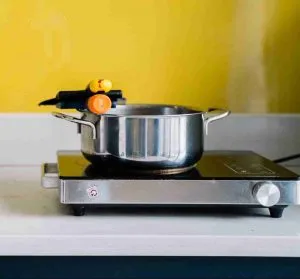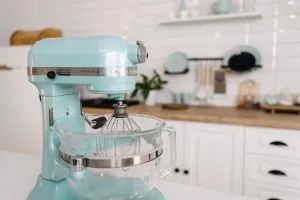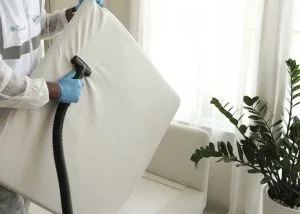Contents
ToggleKey Takeaway:
- Regular cleaning is essential for maintaining the sparkle and attractiveness of porcelain sinks. Neglecting regular cleaning can lead to the accumulation of stains and the deterioration of the sink’s appearance.
- The best way to clean porcelain sinks is to establish a regular cleaning schedule, using mild soap and warm water for routine cleaning. It is important to protect the smooth glaze finish from damage by avoiding the use of hard abrasives and acidic cleaners.
- For removing porcelain stains, a variety of methods can be used. An all-natural approach with baking soda, lemon, and vinegar can be effective, or you can enhance a baking soda cleanser with hydrogen peroxide and oxygen bleach. Chlorine bleach should be used as a last resort for white porcelain.
Introduction
Hey there, home cleaning warriors! Ever looked at your porcelain sink and wondered how to bring back its lost sparkle? Don’t worry, we’ve got you covered. In this guide, we’re going to spill the beans on the best tips and tricks to make your sink shine bright like a diamond. You’ll discover how to combat those pesky stains, fend off future discoloration, and make your porcelain sink the star of your kitchen or bathroom once again. So buckle up and get ready for a fun cleaning ride that’ll turn your porcelain blues into a shiny success story! Let’s get started, shall we?
Importance of regular cleaning for porcelain sinks
Hey, nobody wants a grubby sink! That’s why regular cleaning is the secret sauce to keeping your porcelain sink not only looking snazzy but also last longer. So, let’s dive into why making friends with a sponge and some gentle cleaner is your best bet for a fabulous-looking sink.
Regular cleaning is like that apple a day—it keeps the ‘sink doctor’ away. It prevents your porcelain buddy from becoming a horror show of stains and keeps it looking showroom-fresh.
Let’s dish out some practical tips to make sure your sink stays in the spotlight and stubborn stains don’t steal the show. Get ready to make your porcelain sink the envy of every kitchen item!
Keeping porcelain sinks low-maintenance and attractive
So, you’ve got a porcelain sink and you want it to keep looking snazzy without busting a sweat over it? No worries, I’ve got you covered! Check out these handy-dandy tips:
- Regular Cleaning: By establishing a consistent cleaning schedule, you can prevent the accumulation of stains and keep your porcelain sink looking pristine.
- Gentle Cleansing: Use mild soap and warm water for routine cleaning. This will effectively remove dirt and grime without causing any damage to the smooth glaze finish.
- Avoid Harsh Cleaners: Stay away from hard abrasives and acidic cleaners as they can scratch or etch the surface of your sink, making it more prone to stains.
Keeping Your Porcelain Sink Pretty and Practical: Some Top Tips
So, you’ve got a porcelain sink and you want it to keep looking snazzy without busting a sweat over it? No worries, I’ve got you covered! Check out these handy-dandy tips:
- Be a Regular Reggie: You know how you have that routine cup of joe every morning? Same thing here, only it’s your sink you’re sipping at, not a cup. Regular cleaning keeps the grime away and your sink shining bright.
- Softly, Softly: Your sink isn’t a dirty carpet, so don’t go scrubbing at it with harsh cleaners. All you need is some mild soap and warm water. Just like a gentle lullaby, this combo will sing away the dirt and grime without scratching that beautiful glaze.
- Avoid Sink Saboteurs: Abrasives and acidic cleaners are a big no-no. They’re like termites for your porcelain, gnawing away at it and making it vulnerable to stains. Keep them at bay to keep your sink at its best.
Looking for some extra tricks to keep that porcelain gleaming? Natural solutions like baking soda, lemon, and vinegar mix work like magic on stains and won’t harm your sink. For stubborn stains like metal or rust, try using naval jelly. And if you’ve got some really stubborn stains digging their heels in, call in the Bar Keeper’s Friend.
Remember, a quick rinse after each use can keep your sink looking like a porcelain superstar.
So, don’t let your sink turn into a weird science experiment. Keep it clean, fresh, and ready to shine!
And remember, as the old saying goes, “A clean sink is a happy sink!”
Avoiding neglect and the accumulation of stains
Here’s the thing: leaving your porcelain sink unattended is like inviting dirt to a party and letting it hang around forever. Yuck, right? So, let’s stop the build-up of stains with these foolproof tips:
Be a Cleaning Champ: Don’t wait for a layer of grime to make a home in your sink. With a regular cleaning schedule, you’ll nip this problem in the bud. Think of it like brushing your teeth – something you wouldn’t skip, right?
Treat it Gently: A bit of warm water, some mild soap, and you’re good to go! No need for hard abrasives or acidic cleaners that damage your sink’s smooth glaze finish. That’s like using a chainsaw when all you need is a butter knife!
Natural Magic: If a stain gatecrashes the party, send it packing with an all-natural cleaning solution. A mix of baking soda, lemon, and vinegar works like a charm without doing any harm.
For Stubborn Stains: If you have some truly stubborn stains that have overstayed their welcome, bring out the big guns – Naval jelly or Bar Keeper’s Friend. These tough stain-busters will get the job done right.
Think of maintaining your porcelain sink like giving it a spa treatment every week. It’s a little bit of pampering that will make it sparkle and shine, while keeping it as fresh as a daisy. So why wait? Get scrubbing and make your sink the superstar it deserves to be!
The best way to clean porcelain sinks

Ah, porcelain sinks – elegant, timeless, and occasionally, a bit of a challenge to keep spotless. Fear not, for I’m about to share the ultimate game plan to keep your sink gleaming and glorious.
- First things first, let’s talk about making cleaning a regular part of your sink’s lifestyle. You know what they say, “a little bit of prevention is worth a pound of cure”. Regular cleaning keeps those annoying stains and grime at bay, so they never get a chance to settle in and make themselves at home.
- Next, we’ll step into the world of warm water and mild soap – your sink’s new best friends. These two work their magic to gently lift and wash away everyday dirt, all while pampering your porcelain to keep it in tip-top condition.
- Now, protecting that silky, smooth glaze finish is an art in itself. We’ll uncover those clever techniques that guard against any potential damage and keep your sink’s shine on point.
- Finally, we’ll sound the alarm on hard abrasives and acidic cleaners – they’re the bad guys in our porcelain story. Sure, they might seem effective, but they’re causing harm that could spoil your sink’s good looks.
So, ready to dive in and get your porcelain sink sparkling? Let’s do this!
Establishing a regular cleaning schedule
Maintaining the cleanliness of your porcelain sink doesn’t have to be a monumental task. In fact, establishing a regular cleaning routine is your best bet for keeping your sink shining like new. Here’s a six-step guide to making that routine a breeze:
- Mark Your Calendar: First, choose a cleaning day that fits seamlessly into your schedule. This helps ensure your sink gets its much-needed spa treatment regularly.
- Arm Yourself with the Right Tools: Collect your cleaning arsenal. You’ll need mild soap, warm water, a sponge or soft cloth, and specific cleaners if necessary.
- Clear the Deck: Begin by emptying your sink of any clutter or debris. This gives you unhindered access to the sink’s every nook and cranny.
- Soap and Water – A Classic Combo: Mix a gentle soap with warm water. Use this solution to wash down your sink’s surface, both inside and out, with your chosen cloth or sponge.
- Address Those Hard-to-reach Spots: Using an old toothbrush or a small brush, gently scrub away any dirt or grime that’s hiding out in corners or crevices.
- Rinse and Dry: Once you’ve scrubbed every inch, rinse away any remaining soap residue with warm water. Pat the sink dry with a clean cloth or towel to avoid water spots.
Remember, this guide is flexible. Feel free to tweak these steps to suit your lifestyle and sink’s needs.
By sticking to this routine, you’ll not only keep your porcelain sink looking spick and span, but you’ll also save yourself the struggle of dealing with stubborn stains later on. All it takes is a little bit of time and some mild soap and warm water to keep your sink sparkling for years.
Using mild soap and warm water for routine cleaning
Think of routine cleaning as a little pampering session for your porcelain sink. Using a mild soap and warm water combo can do wonders to maintain its shine without causing any damage. Let’s break down how to incorporate this easy, yet effective cleaning method into your sink-care routine:
- Mild soap: Using a mild soap specifically formulated for delicate surfaces is an essential step in maintaining the cleanliness of your porcelain sink. The gentle nature of this type of soap ensures that it effectively removes dirt and stains without causing any harm.
- Warm water: The use of warm water in combination with a mild soap creates an ideal cleaning solution for routine maintenance. Warm water helps to break down grease and grime more effectively, allowing for easier removal.
- Non-abrasive sponge or cloth: When cleaning your porcelain sink, it is crucial to use non-abrasive materials such as a soft sponge or cloth. These tools will help prevent any scratches or damage to the smooth glaze finish while still achieving a thorough clean.
- Gentle scrubbing motion: To remove stubborn stains or dirt buildup, apply the mild soap and warm water solution to the affected areas and gently scrub using circular motions. This technique will ensure even coverage without causing any harm to the surface.
- Thorough rinsing: After cleaning your porcelain sink with mild soap and warm water, make sure to thoroughly rinse off any residue to avoid leaving behind a soapy film or potentially causing discoloration over time.
Routine cleaning with mild soap and warm water is more than just a cleaning trick; it’s your secret weapon for a porcelain sink that stays stunning for years to come. It helps you prevent the buildup of tough stains, saving you both time and elbow grease in the future.
So, don’t miss out on the chance to let your porcelain sink shine its brightest. Embrace the power of mild soap and warm water, and enjoy the sight of a sparkling, well-maintained sink that truly lights up your kitchen or bathroom.
Remember, your porcelain sink is a gem – treat it as such with these foolproof cleaning tips!
Protecting the smooth glaze finish from damage
Maintaining the sparkly finish of your porcelain sink isn’t rocket science; it just needs some TLC (Tender Loving Care). Here’s how you can keep that glaze looking brand-new:
- Handle With Care: Think of your sink like a precious piece of china. Don’t drop heavy or sharp objects in it to prevent chipping or scratching its smooth surface.
- Use Gentle Cleaning Tools: Always use soft sponges or cloths for cleaning. Rough materials are like sandpaper to the glaze, so stick to gentler alternatives.
- Ditch the Harsh Chemicals: Harsh chemicals or abrasive cleaners are a no-no for your porcelain. Instead, reach for mild soaps or cleaners specially made for porcelain surfaces.
- Maintain Regularly: Consistent cleaning keeps dirt and grime from building up and harming the glaze. A quick wipe after each use and a deeper clean now and then can go a long way!
By sticking to these simple guidelines, your porcelain sink will remain as smooth and shiny as the day you bought it, stealing the show in your kitchen or bathroom.
As the Home Depot pros would tell you, regular cleaning and proper care can significantly lengthen the lifespan of your porcelain sink.
So, keep it simple, avoid kitchen disasters, and remember: keeping your sink shiny doesn’t require a lab coat, just some good old-fashioned TLC!
Avoiding the use of hard abrasives and acidic cleaners
It’s crucial to remember that your porcelain sink isn’t a fan of harsh cleaners and rough scrubbing. A little love and care will go a long way in preserving its shiny appearance and preventing damage. Here’s a simple guide to keeping your sink in great shape:
- Opt for mild soap: Instead of harsh chemicals, use a mild soap and warm water solution for routine cleaning. This gentle approach will effectively remove dirt and grime without damaging the porcelain surface.
- Establish a regular cleaning schedule: By staying consistent with your cleaning routine, you can prevent the build-up of stains and keep your sink looking pristine. Make it a habit to clean your sink at least once a week.
- Protect the smooth glaze finish: The smooth glaze finish of porcelain sinks is delicate and prone to scratches. Avoid abrasive scrub brushes or scouring pads that can mar the surface. Opt for soft sponges or microfiber cloths instead.
- Say no to hard abrasives: Harsh abrasives like steel wool or powdered cleansers can cause irreversible damage to your porcelain sink. These materials can create scratches and wear down the glaze, leading to a dull appearance over time.
- Steer clear of acidic cleaners: Acidic cleaners such as vinegar or lemon juice may be effective in removing stains, but they can also erode the protective glaze layer on porcelain sinks. It’s best to avoid using these substances altogether.
- Use non-acidic alternatives: If you need an extra boost in tackling stubborn stains, try non-acidic cleansers specifically designed for porcelain sinks. These products are formulated to be tough on grime while gentle on the surface.
By following these guidelines, not only will you maintain your porcelain sink’s dazzling looks, but you’ll also increase its lifespan. So, ditch the harsh cleaners, and say hello to a sparkling, brand-new looking sink!
Methods for removing porcelain stains

Got a case of stubborn stains on your porcelain sink? Don’t sweat it! Here’s a handy guide to three surefire methods that’ll get your sink looking like new in no time.
- The Nature-Powered Trio: Let’s kick things off with an all-natural solution. By harnessing the cleaning power of everyday items – baking soda, lemon, and vinegar – you’ll be amazed at what you can accomplish!
- Supercharged Baking Soda: If you’re dealing with a more stubborn situation, it’s time to step up the game. Add hydrogen peroxide and oxygen bleach to your baking soda for an even more potent clean.
- The Final Frontier – Chlorine Bleach: If all else fails, and your sink is white porcelain, we can call upon our last resort – chlorine bleach. But remember, we save this one for only the toughest of stains.
So, strap in, roll up those sleeves, and let’s get your sink back to its sparkling best!
All-natural approach with baking soda, lemon, and vinegar
Dirty porcelain sink got you down? Don’t worry, we’ve got an all-natural, kitchen-friendly solution for you! Whip out your baking soda, a lemon, and some vinegar, and let’s get started on this eco-friendly cleanup!
Follow these easy peasy steps:
- Create a paste by combining baking soda and lemon juice. The abrasive nature of baking soda helps lift stains while the acidity of lemon juice helps break them down.
- Apply the paste to the stained areas of your porcelain sink. Use a soft cloth or sponge to gently scrub in circular motions, ensuring that you cover all the stained surfaces.
- Let the baking soda and lemon juice mixture sit on the stains for a few minutes. This allows the solution to penetrate and work its magic on the stubborn marks.
- After letting it sit, rinse the area thoroughly with warm water. Make sure to remove all traces of the paste from your sink.
- To finish off, create a mixture of equal parts vinegar and water in a spray bottle. Spritz this solution onto your entire porcelain sink and wipe it down with a clean cloth or sponge. Vinegar helps disinfect and deodorize, leaving your sink fresh and clean.
With this natural, DIY method, you can get rid of the stains on your porcelain sink effectively, and without any harmful chemicals.
Before you dive in, remember to do a little test run on a hidden area of your sink to make sure this solution is compatible with your porcelain.
Fun fact alert! Vinegar isn’t just for salads. This kitchen staple has been used as a powerful cleaning agent for centuries, dissolving pesky mineral deposits and stubborn stains.
Ready to level up your cleaning game? Stay tuned as we explore how baking soda teams up with hydrogen peroxide and oxygen bleach for even more cleaning prowess.
Enhancing baking soda cleanser with hydrogen peroxide and oxygen bleach
Ready to give your porcelain sink a deep clean? Time to bring out the big guns: baking soda, hydrogen peroxide, and oxygen bleach. This trifecta packs a punch against even the most stubborn of stains.
Here is a simple 5-step guide to follow when enhancing your baking soda cleanser:
- Start by creating a paste: Mix equal parts baking soda and hydrogen peroxide in a small bowl until you achieve a thick, spreadable consistency.
- Apply the paste to the stained areas: Using a soft cloth or sponge, apply the baking soda paste directly onto the stains on your porcelain sink. Make sure to cover the entire affected area.
- Let it sit: Allow the enhanced cleanser to sit on the stains for about 15-20 minutes. This will allow the ingredients to penetrate and loosen up the dirt and grime.
- Scrub gently: After the sitting time has passed, take a non-abrasive sponge or brush and gently scrub the stained areas in circular motions. Be careful not to apply excessive force that could damage the porcelain surface.
- Rinse thoroughly: Once you have scrubbed away the stains, rinse your sink thoroughly with warm water. Make sure no residue from the cleaning mixture is left behind.
This enhanced baking soda cleanser is your secret weapon against stubborn stains. But remember, it’s powerful stuff, so use it sparingly to avoid damaging your sink’s shiny glaze.
As with any cleaner, make sure to do a small test on a hidden part of your sink before going all out.
Fun Fact: This super-charged method was born out of homeowners’ experiments to find the most effective solutions for stubborn porcelain stains. It turns out; this combination does a stellar job without harming the surface.
Speaking of super-charged solutions, next up we have chlorine bleach – your sink’s very own superhero, swooping in to save the day when all else fails.
Using chlorine bleach as a last resort for white porcelain
When it comes to cleaning white porcelain sinks, chlorine bleach is like your secret weapon stashed away for those stubborn, tough-to-beat stains. It’s like a superhero, showing up when all else fails.
But remember, with great power comes great responsibility. Here’s the game plan:
- Dilute: Start by watering down the bleach, as it’s pretty potent stuff.
- Apply: Next, gently dab the diluted bleach onto those pesky stains.
- Wait: Let the bleach work its magic for a few minutes. Grab a coffee, read a magazine, just let it do its thing.
- Scrub gently: After the bleach has had time to sit, give it a gentle scrub with a soft cloth or brush.
- Rinse thoroughly: Finally, rinse away all the bleach and marvel at your sparkling sink.
Bear in mind, though, that bleach should be your last resort. It’s pretty harsh stuff and, if used too frequently, can damage the glaze finish of your porcelain sink. So, tread lightly, and always handle with care.
In the fight against stains, chlorine bleach is your ace in the hole for white porcelain. Just remember to play it safe and use it wisely!
So, when stains are hell-bent on ruining your porcelain’s shine, don’t let them win. Let our top picks for porcelain cleaning products come to your rescue!
Recommended porcelain cleaning products
Let’s face it – the battle against stains on your porcelain sink is real. But fear not, I’ve got two tried-and-true warriors that can help you fight off those pesky invaders.
First up, meet Naval Jelly. This stuff is a true lifesaver when it comes to handling tough metal or rust stains that have overstayed their welcome on your porcelain sink. With a quick application, your sink will be sailing back to its shiny glory days.
Next, we have the powerful Bar Keeper’s Friend. Now, this friend truly lives up to its name. Those stubborn, set-in stains that refuse to budge? Bar Keeper’s Friend takes them head-on and brings back the gleaming brilliance to your porcelain sink.
So, grab your armor (or rather, these two excellent cleaning products), and prepare to vanquish those troublesome stains from your porcelain kingdom!
Time to wage war on those porcelain stains with Naval Jelly and Bar Keeper’s Friend by your side.
Naval jelly for tough metal or rust stains
Tired of those gnarly metal or rust stains on your porcelain sink? Allow me to introduce you to a potent ally: Naval Jelly. Here’s a 4-step guide on how to wield this rust-busting wonder:
Step 1: Suit Up – Slip on a pair of protective gloves and get ready to wage war on those stains.
Step 2: Attack – Slather a thick layer of Naval Jelly right on those pesky rust spots.
Step 3: Patience, Grasshopper – Let the jelly sit for about 5-10 minutes. Give it some time to dissolve and lift that stubborn rust.
Step 4: Gentle Scrub-a-dub – Using a non-abrasive brush or sponge, gently scrub in circular motions. Need more jelly? No problem! Slather on as needed.
Step 5: Rinse and Shine – Rinse everything off with warm water, making sure to wash away all the Naval Jelly.
Remember, Naval Jelly can be a bit stinky, so ensure the area is well ventilated while you’re using it. And don’t forget to follow the manufacturer’s safety guidelines too.
And just like that, you’ve turned the tide in your battle against metal and rust stains! Your porcelain sink’s shine is restored.
But wait, there’s more! For those relentless stains that have moved into your porcelain sink without an invite, bring in the big guns – Bar Keeper’s Friend. This heavy-duty cleaner shows no mercy to stains, bringing only cleanliness and shine in its wake!
Bar Keeper’s Friend for deep set-in stains
Let’s talk about those hard-to-beat stains on your porcelain sink that have overstayed their welcome. Well, it’s eviction time! And Bar Keeper’s Friend is just the muscle you need.
This robust cleaner dives deep, busting up and banishing stubborn stains from your porcelain sink’s surface. The secret is its gritty texture that scrubs without scratching your sink’s delicate porcelain finish.
Bar Keeper’s Friend doesn’t discriminate – it battles rust, hard water residue, soap scum, and other bathroom culprits with equal gusto.
To use it, just grab a non-abrasive sponge or cloth, dab some Bar Keeper’s Friend on it, and scrub those stains in a gentle, circular motion.
Follow that up with a good rinse using warm water, and voila – you have a sink that’s not just clean, but positively gleams!
And if you’re wondering about the rest of your bathroom arsenal, fret not – Bar Keeper’s Friend is also safe to use on stainless steel, ceramic, and glass.
Pro Tip: Want to really stick it to those stains? Let Bar Keeper’s Friend sit on the stained area for a few minutes before you scrub. This allows it to work its magic and penetrate deeper into the stains.
Maintaining your porcelain sink with weekly cleaning
Keeping your porcelain sink in tip-top shape is all about regular, gentle care. Here’s a simple six-step guide to making your sink shine:
- Easy Does It: Choose soft, mild cleansers designed for porcelain. You want to clean, not scratch your lovely sink.
- Softly, Softly: Don’t be too rough! Use gentle scrubbing tools like soft sponges or non-abrasive cloths.
- Rinse and Repeat: After every use, a rinse with warm water can help remove any leftover residue and prevent stains.
- Make it a Routine: Get into the habit of a weekly cleaning session. Just a wipe-down with a mild detergent solution or a mix of vinegar and water can do wonders.
- Stain-Busters: Stains can be stubborn. But a paste of baking soda and water can gently scrub them away. Apply the paste, scrub gently, then rinse.
- Dry Off: After each clean, be sure to dry the sink with a soft cloth. This will prevent water spots and buildup of calcium.
Remember, your porcelain sink doesn’t like harsh cleaning agents or rough scrubbing brushes, so avoid using them. If you stick to this routine, your porcelain sink will stay gleaming for years.
Pro Tip: After each clean, give your sink a quick buff with a microfiber cloth. It’s like the cherry on top, for an extra sparkling sink!
Conclusion
There you have it, a complete guide on how to take a stained porcelain sink from drab to fab. While these tips can work wonders, remember, some stains are just too stubborn and might need professional help.
But don’t forget the magic lies in the upkeep. Regular care and some simple preventive steps can go a long way. Incorporate these tips into your cleaning routine and you’re all set for a porcelain sink that shines like a diamond for years on end.
In the end, it’s all about enjoying a gleaming, clean sink every day. Happy cleaning!
Five Facts About Cleaning a Stained Porcelain Sink:
- ✅ Porcelain sinks should be cleaned at least once a week to prevent stains and maintain their appearance. (Source: Team Research)
- ✅ A daily wipedown with mild soap and warm water can help remove soap scum, toothpaste, and other grime from a porcelain sink. (Source: Team Research)
- ✅ Baking soda is an effective and gentle scrub for removing minor stains from a porcelain sink. (Source: Team Research)
- ✅ Hydrogen peroxide and oxygen bleach can be used to enhance the cleaning power of baking soda and remove yellow stains from porcelain sinks. (Source: Team Research)
- ✅ Chlorine bleach should only be used on white porcelain sinks and must be applied to a completely clean sink to avoid dangerous reactions. (Source: Team Research)
FAQs about How To Clean A Stained Porcelain Sink
How often should I clean my porcelain sink?
The best way to keep your porcelain sink stain-free is by incorporating it into your regular cleaning routine. It is recommended to clean the sink at least once a week, but giving it a daily wipedown can help maintain its like-new luster.
What should I use to clean my porcelain sink?
Mild soap and warm water are usually sufficient for cleaning a porcelain sink. It’s important to use a soft sponge or gentle scrubber to avoid damaging the smooth glaze finish. Avoid using hard abrasives like steel wool and be cautious with acidic cleaners, as they can dull the sink’s finish. Always rinse the sink thoroughly after using any acidic cleaner.
How can I remove stains from my porcelain sink using natural ingredients?
A mixture of baking soda and water can create a soft scrub that effectively removes minor stains from a porcelain sink. Gently scrub the stained areas with the baking soda paste using a sponge or cloth. If the stains persist, rubbing lemon wedges or using an undiluted vinegar spray can help tackle the tough stains. Rinse the sink thoroughly after removing the stains.
What can I use to get rid of yellow stains on my antique or colored porcelain sink?
For yellow stains on antique or colored porcelain sinks, you can enhance the cleaning power of baking soda by adding hydrogen peroxide to the sponge. Hydrogen peroxide, along with oxygen bleach, is the most effective household cleaner for tough stains on these types of sinks. Soak paper towels with hydrogen peroxide and let them sit on the stained areas for at least half an hour before rinsing the sink.
Can I use chlorine bleach to remove tough stains from my white porcelain sink?
Yes, chlorine bleach can be used to remove tough stains from white porcelain sinks. However, it is important to note that bleach should only be used on white porcelain, as it can damage the color and finish of vintage or colored porcelain. Apply bleach-soaked paper towels to the stained areas and let them sit for at least 30 minutes before rinsing the sink. Ensure the sink is completely clean and free from any vinegar or chemical residue before applying bleach.
Are there any specialized cleaning products I can use for stubborn stains on my porcelain sink?
If natural remedies or regular cleaning products don’t work, there are specialized cleaners available for porcelain sinks. Naval jelly can be used for tough metal or rust stains, while Bar Keeper’s Friend is a gentle yet strong multi-purpose cleaner suitable for porcelain. Follow the instructions provided with these cleaners and make sure to rinse the sink thoroughly after use to avoid any damage to the porcelain.
Additional Reading
Expand your knowledge on various cleaning techniques and home maintenance tasks with these useful reads:
- How to Remove Turmeric Stains: Similar to the stubborn stains on a porcelain sink, turmeric stains can be difficult to remove. Learn the best techniques to eliminate them in this guide.
- Measure Twice, Install Once: How to Measure Kitchen Sink: When you’re considering replacing a stained sink, knowing how to accurately measure your kitchen sink for a replacement can come in handy.
- Get Soap Out of Carpet: Getting soap out of carpet can be tricky. Understanding how to deal with such spills could be beneficial in maintaining the cleanliness of your home.
- Why Does Poop Smell Linger on Skin?: This article explores why certain smells stick around and how to effectively get rid of them. It might provide insights into removing persistent odors from your porcelain sink.
- I Dropped My Vape in the Toilet: Accidents happen and sometimes they involve our toilet and personal items. Learn how to clean and restore your items in such situations.























































